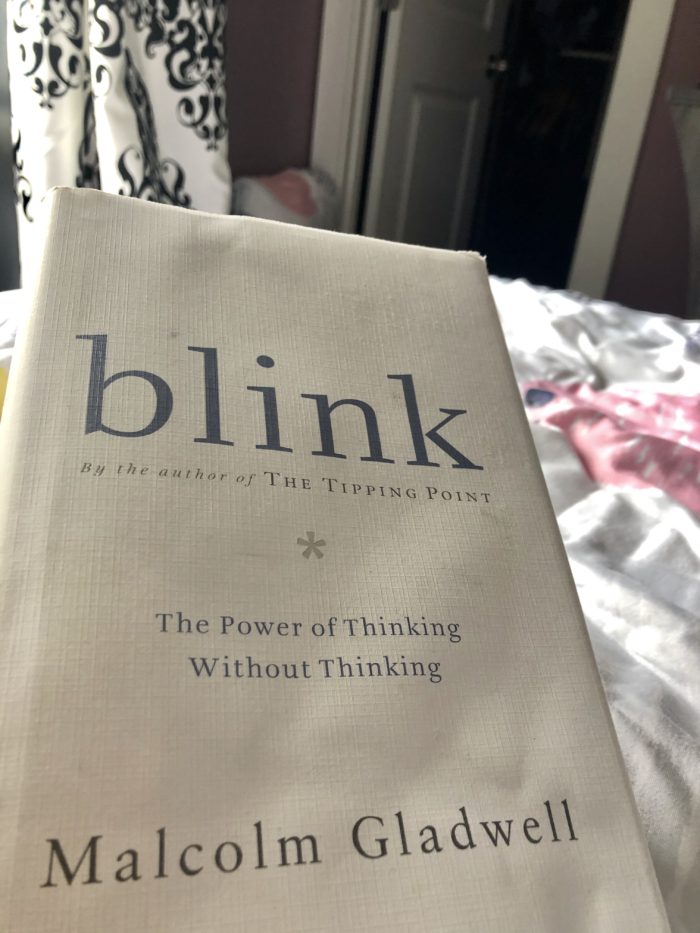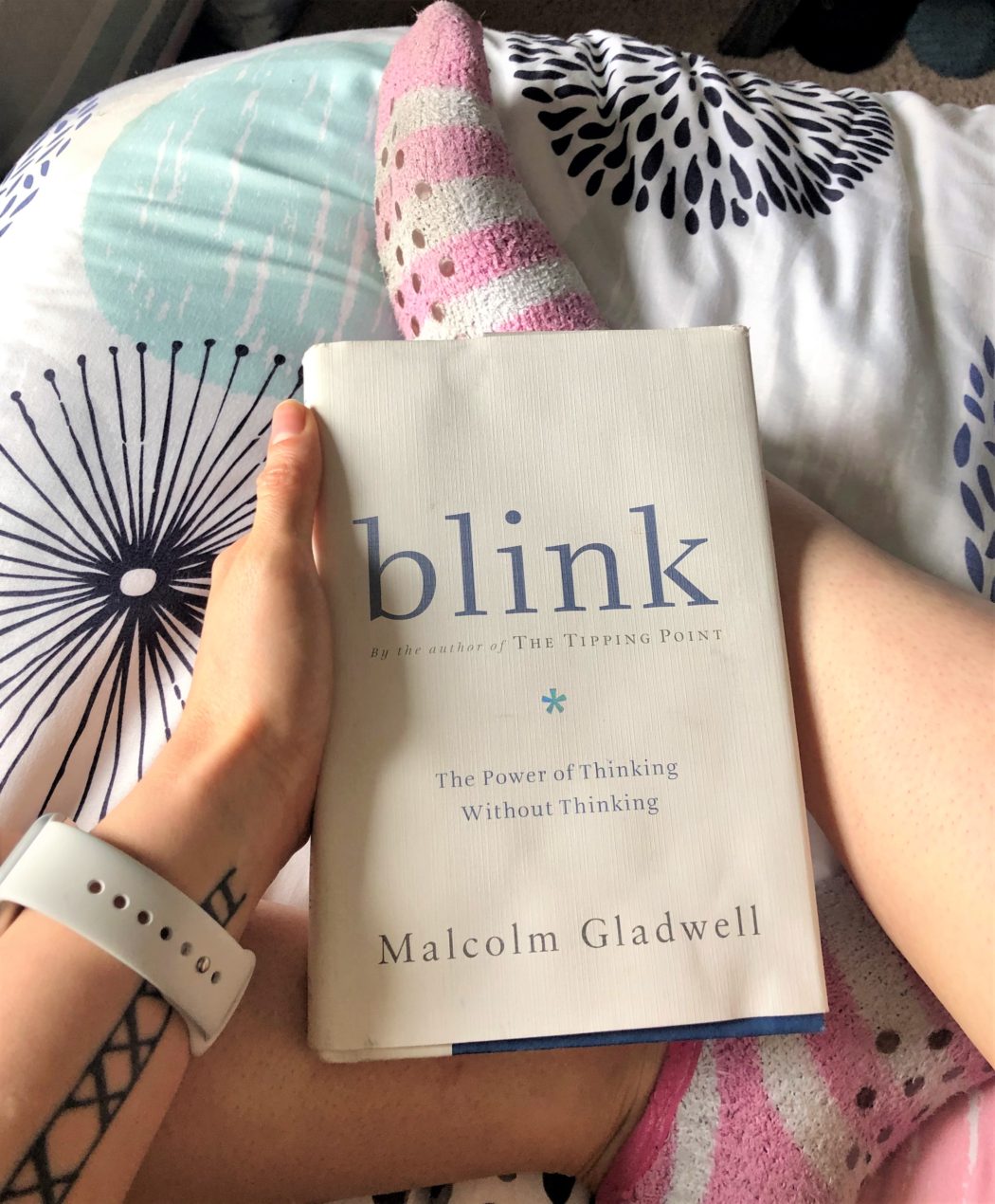blink, by Malcolm Gladwell, was a book I’d looked forward to reading for a long time. And I was really enjoying it, even if I didn’t agree with every conclusion, until about 3/4 of the way through. That’s when everything took a turn.
After owning a second-hand copy of blink for a year, or more, I was finally reading it. I’m late to the game, I guess, since Gladwell seems to be everywhere and I’ve been interested in getting to know his writing for a long time. I was primed to like it. I wanted to like it. But early on, I didn’t necessarily agree with all of his conclusions from the data collected. But these types of books, based on theory from research, are like that. Opinions and the way you see the data matter. So it didn’t faze me too much.
The Point of Thin-splicing
Despite the fact that the book is all about “thin-splicing”, that split second where your subconscious makes a decision based on things you don’t even realize you saw or heard, there is a lot of research behind the reasoning for it. To make his point, Gladwell cites examples for us from years of studies by experts with tons of tests and subjects. Gladwell makes cases for some situations where you need to create a ton of data to draw conclusions from, then strip it down to just what you need; and plays his own devil’s advocate for situations when data is a handicap and a person should just go by feel.
The problem lies in the fact that Gladwell’s explanations of the “why” of thin-splicing are either too watered down or simplified. He often states truth in cases that didn’t have a big enough testing pool. Which I guess is the point for part of the book. When, for example, he explains the backlog of patients in Cook County Hospital because they over-analyzed heart attack risks. Or how the musician, Kenna, with a rabidly loyal and large-enough fan base, was ignored by radio because he didn’t fit the radio’s popularity algorithm.
But sometimes oversimplifying is a detriment. He explains that you can recognize a face in a line-up easier than you can be asked to describe it on paper because it uses different parts of the brain. You lose data as you try to write it in black-and-white, which he goes into in detail in the book. Gladwell’s whole book is basically suffering from this problem. Sometimes it can be done and sometimes you forget what you saw. I think in this book, Gladwell often forgets what he saw.
Especially when he describes autism.
What is Gladwell’s Problem With Autism?
Gladwell oversimplifies what autistic people feel and think through what they see. And it’s based on ONE example (which I’ll go into later). Gladwell takes this one example of one autistic adult male and makes a generalization about the way autistic people relate to, and react to, the whole world: which creates a stereotypical sense of autism.
Autism is a spectrum and a complex one at that. It can’t (and shouldn’t!), be explained by one test of one man and be used as a definitive explanation of all autistic experiences. This is stereotyping. This is prejudice. And Gladwell’s prejudice seems to cloud his judgement of this subject.
I have an autistic son and, far from being a simplistic and robotic human being, despite often seeing the world in black & white, is one of the most complex and varied people I know. He can also be more honest and deeply caring than anyone else.

Although the raw data from the study in the book is largely correct, it’s not a complete picture and doesn’t create an understanding of autism. (Clearly, by Gladwell’s reaction and subsequent conclusions). Yes, people with autism can take longer to identify facial expressions and distinguishing importance between people and objects, but that doesn’t mean they’re inhumane or lack feeling. My son reacts differently to me versus a chair. So, even though there is evidence to support the one example in the book, it isn’t the whole story, but one layer of an onion, and more research needs to be done.
An Unworthy Comparison
Especially troublesome is the next chapter that likens emotional arousal mind-blindness to autism. He continually compares one autistic man’s experience watching a movie with the examples of police brutality. Let me explain further…but it’s as ridiculous as it sounds.
The other research in the book (from successful salesmen to speed dating to war room research) has a wide net- years of research and test subjects. Even when it just pertains to what food people like, the researchers make sure they have a wide variety of people, ages, times, and situations.
But Gladwell is happy with a single flawed “test” of autism.
The example with which he rates all autistic people as potentially psychotic robots is based on one instance. In this example, one highly-functioning autistic man watches the movie version of, Who’s Afraid of Virginia Woolf?, and his eye movements are tracked. He finds objects more important than kissing in a scene or people’s faces (he’s fascinated with light switches, they’re his thing), doesn’t understand pointing, and laughs in the final tense scene when the gun turns out to have a pop-out umbrella rather than bullets.
He doesn’t read the emotions correctly. He laughs at guns. Gladwell concludes that it’s because he doesn’t feel the tension, is emotionless, and therefore sees the gun as harmless. It couldn’t be not knowing how to react to the element of surprise. It must be because he doesn’t care about people, right? That he sees them as inconsequential? That means he could zero in on only one thing he likes, such as a light switch, and dispense with what he doesn’t care about, which is people, if he was agitated. He has “mind-blindness” to emotions and the human condition. Correct?
No.
Wrong.
They then test “normal” (Gladwell’s term) people, several of them, in fact, watching the same movie. THEY watch the people’s faces, understand pointing and don’t laugh at the gun. However, they never have more people on the spectrum watch the movie and track their eye movements. They base it on one man and his one caretaker’s opinion. Gladwell, and the study he cites, completely ignore the fact that autism is a huge spectrum and incredibly varied. Instead, he uses this one example to form an entire opinion and cites it again and again, unlike his reaction to other researched examples in his book. (Now who has “mind-blindness”).
He goes into examples of police and how adrenaline affects their decision-making process- often leading to violence and unwarranted police brutality. Gladwell states that police in a state of adrenaline get to a point of arousal that hikes their heart-rate, shutting down some of the brain’s response systems, thus leaving them “mind-blind” to social and emotional cues (and, therefore, rational responses). This creates the perfect storm for (implied excusable) violent behaviour due being “mind-blind”. He explains that the cops, in these situations, are experiencing, “temporary autism”.

Gladwell states a few cases where police have shot someone, in most examples, a black male, wrongfully. He implies ambiguity in every situation and seems to have sympathy for the cops on duty. Gladwell explains it away with how much time they have to react and the “temporary autistic state of being mind-blind” due to the adrenaline rush.
In this way, Gladwell creates a bridge between his understanding of autism and the happenings of police brutality when in a state of arousal- saying both are situations of the same mindset. Over and over, Gladwell seems to be sympathetic with the officers, when they warrant very little, if any at all. In the Diallo case, which he goes back to at the end, he describes the cops on duty as raw and inexperienced, as a reason for their rash decision making that ended in Diallo dead.
In the previous pages, he has just finished detailing the extensive training officers get before they go on patrol to be effective and not impulsive. In fact, he keeps repeating the fact that the one police officer cried after the Diallo shooting but he neglects to observe that many people cry after an adrenaline rush as an emotional release, regardless of their state of remorse.
I believe he’s repeating it to incite our sympathy for the police officer. Gladwell states that if it weren’t for the “temporary state of autism”, that tragedy wouldn’t have occurred.
Gladwell’s misunderstanding of autism borders on disgust and fear. Let me give you some examples, direct from his book:
“What police training does, at its best, is teach officers how to keep themselves out of this kind of trouble; to avoid the risk of momentary autism.”
Pages 234-235
“What Fyfe found was that the officers were really good when they were face-to-face with a suspect and when they had the suspect in custody. In those situations, they did the “right” thing 92 percent of the time. But in their approach to the scene, they were terrible, scoring just 15 percent. That was the problem. They didn’t take the necessary steps to steer clear of temporary autism.”
Page 236
(Regarding the Diallo case)
“They are in the line of fire, and what Carroll sees is Diallo’s hand and the tip of something black. As it happens, it is a wallet. But Diallo is black, and it’s late, and it’s the South Bronx, and time is being measured now in milliseconds, and under those circumstances we know that wallets invariably look like guns. Diallo’s face must tell him something different, but Carroll isn’t looking at Diallo’s face- and even if he were, it isn’t clear that he would understand what he saw there. He’s not mind-reading now. He’s effectively autistic.”
Page 243
On top of that last quote sounding racist, this causes the reader to make a connection, with Gladwell’s heavy guiding hand and repeated phrase connection, that an autistic person is a robotic, mind-blind, potentially dangerous person.
This assumption is very, very, very wrong.
There are good points in this book and some was fascinating. I’m aware that some of these theories have been widely tested and proven, over and over, even. Some of these theories have become a permanent part of our culture. One example would be employing people that can tell if a suspect is lying based on facial expression and gestures.
Yet, Gladwell remains way off base with autism. He’s so clinical in this book, and so insistent that autism practically equals psychopathy, it makes me think of the homophobic closeted homosexual.
Whatever the reason for Gladwell’s conclusions, it’s his kind of thinking that makes the world a dangerous place for my son, and a potential victim, rather than a potential criminal.
Autistic people are more often than not the victims. Since people who have autism see the world in more literal terms, they always say what they mean. (Some learn to do it in a less blunt way, but most are incapable of lying- or I know Hunter is). Because of this, they expect you to communicate in the same way- literal, honest meaning. Not in an infantile or simple-minded way. It’s how the world works from their perspective- things are a bit more cut and dried. It makes them more susceptible to predators, bullying and schemes. Which Gladwell can’t seem to understand.
Autism and autistic people are incredibly complex, like everyone else. A point that Gladwell’s over-analytical book, due to his own prejudice, misses.
.
.
.
Read next:

[…] are filled with stories and theories from many points of view. Whether we agree with them or not, they help us see the world through other’s eyes and build a foundation of what we […]